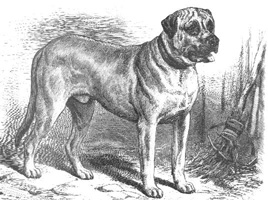|
There is evidence of Mastiff-like
giant dogs dating back as far as 2500 BC in the mountains of Asia. Bas-reliefs
from the Babylonian palace of Ashurbanipal (now on display in the British
Museum) depict Mastiff-type dogs hunting lions in the desert near the
Tigris River. Their coloration, of course, cannot be told, but other than
being taller and leaner than current-day Mastiffs (as ours would be if
raised in a desert and fed lightly), they are remarkably like our modern
Mastiffs, despite the passing of nearly 4500 years.
After this clear visual evidence, we
must rely on folklore and oral history. Phoenician traders are believed to
have introduced the Mastiff to ancient Britain, where the Romans found
them and brought them back to fight in the arena.
Marco
Polo wrote of Kubla Khan, who kept a kennel of 5,000 Mastiffs used
for hunting and war.
When Hannibal, the great Roman
leader, crossed the Alps, he took with him several battalions of trained
war mastiffs, who, during their long travels, "fraternized" with
local breeds to produce what became the St. Bernard, once called the
Alpine Mastiff, as well as other giant breeds.
All of the massive mountain dogs of
Spain, France, Turkey, and the Balkans can trace their size back to
Mastiff blood in their ancestry. Even the Chow Chow carries Mastiff blood,
as does the Pug, which was originally a form of dwarf Mastiff.
Theories advanced by various authors
have focused on one or more of the above to try to identify the *origin*
of the breed. What should matter the most to us is what the breed is like
now, and how it came to be that way. Despite the differences of opinion on
where the Mastiff originated, most agree that the British are the creators
of the breed as we know it today.
Of all the countries who used the
Mastiff, it was the British who kept him in his purest form, and it is to
them that we owe the Mastiff of today. They kept Mastiffs to guard their
castles and estates, releasing them at night to ward off intruders. Henry
VIII is said to have presented Charles V of Spain a gift of 400 Mastiffs
to be used in battle.
The Legh family of Lyme Hall,
Cheshire, who were given their estate by Richard II (1377-1399), kept and
bred Mastiffs for many generations. Stowe's Annual, a reference book,
shows that King James I (1603-1625) sent a gift of two Lyme Hall mastiffs
to Phillip II of Spain. These, or their immediate descendants, are
certainly the Mastiff-type dogs shown in famous portraits of the Spanish
royal children.
Other sources indicate
that Mastiffs were used as war dogs by the ancient Celts, and
accompanied their masters into battle. When the Romans invaded
Britain, they took the dogs back to Italy and used them to guard
property and prisoners, as well as using them to fight in the arena.
The Mastiff was one of the few
breeds mentioned by name in The Forest Laws of King Canute, the first
written laws of England. There, Mastiffs were required to be checked by
the tax collector, who would make sure the middle toes of each front foot
were removed so the dog could not run fast enough to catch the deer (which
traditionally belonged to royalty). Tax collectors have not evolved much
over the centuries; the penalties for failing to meet their requirements
were extreme. In the Forest Laws, Mastiffs were mentioned specifically as
being kept for protection.
In the Elizabethan Era, the Mastiff
was used to fight wild animals (e.g., bears, tigers, etc.), usually for
the entertainment of the Queen. After the cessation of this cruel
sport, Mastiffs continued to be bred by the Dukes of Devonshire and
Sutherland, the Earl of Harrington, and other nobles.
According to the scanty records of
the Pilgrim Fathers, two dogs, a Mastiff and a spaniel, accompanied the
Plymouth colonists aboard the Mayflower on their journey to the new world.
In England, dog showing
became popular in the mid-1800s. Wealthy people kept and bred
Mastiffs and started the first recorded pedigrees. These were
registered with what was then the only kennel club in the world, The
Kennel Club in England.
During the World Wars, Mastiffs were
used to pull munitions carts on the fronts. In America, they were
frequently found on plantations as property guards.
The size of the Mastiff and its need
to eat about as much food per day as an adult human made a Mastiff too
costly for most common folk to keep, except perhaps for butchers. In
England they were sometimes called "the Butcher's Dog" because a
butcher had enough meat scraps to feed a Mastiff well, and could therefore
afford to keep one, even though he was not wealthy.
Mastiffs began to decline in
popularity until the late 1800's, when interest revived briefly, and
Mastiffs started to be imported into America. World War I saw their
decline again in England, and by the 1920's they were almost extinct in
that country in their pure form. It was considered unpatriotic to keep
dogs alive who ate as much in a day as a soldier; entire huge kennels were
put down as a result.
World War II all but finished the
breed in England. At the end of the war, fresh blood was imported from
Canada and the United States to revive the breed. Now, fortunately,
Mastiffs are well established again, the United States having perhaps the
greatest number.
Breeders
today have bred the Mastiff for gentleness and have created an excellent
companion, large enough to deter intruders and yet gentle enough to be
dependable around children. |